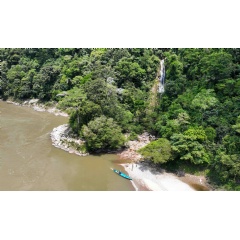Amplifying locally led conservation

To stop the loss of nature, tackle the climate crisis and build a future where people and wildlife can thrive, conservation needs to be everybody’s business.
Around the world, more and more people are taking action for nature where they live – from Indigenous Peoples defending their lands, to fishing communities restoring coastal habitats, to urban residents greening their cities. By deepening our support to these local conservation champions, WWF aims to amplify and expand their efforts and increase their impact.
What does it mean for conservation to be “locally led”?
Effective conservation projects have always involved local people, but locally led conservation goes much further. It’s a power shift: it means local communities are in control, rather than following the agendas of donors and conservation organizations. They identify their own priorities, design projects, make decisions, manage resources and choose their own measures of success.
WWF’s role is to support and amplify their efforts. That includes collaborating with communities on the ground, for example by providing technical support that complements traditional and local knowledge. But it also involves working with communities to claim their rights and help get the support and the funding they need to achieve their goals.
WWF offices in different parts of the world, for example, are helping communities to map their territories and secure recognition of their rights to their lands, waters and natural resources. We also advocate for Indigenous and community rights, traditional knowledge and local conservation efforts to be core elements of national and international policies and processes.
Amplifying locally led conservation benefits us all
Local communities know their environment better than anyone. That knowledge – often built up over many generations – is invaluable in guiding and carrying out effective conservation work, responding to local realities and meeting people’s needs. And when local people benefit from conserving nature, on their own terms, the positive impacts can be long-lasting: while most conservation projects run by NGOs or governments have a limited duration, locally led conservation initiatives are more likely to continue in the long term.
Locally led conservation also has global benefits. Indigenous territories and community lands encompass many of the most important wildlife habitats on the planet, along with critically important stores of carbon. Supporting their continued stewardship is critical to meeting global goals on climate, biodiversity and sustainable development.
What does locally led conservation look like in action?
Around the world, we’re partnering with communities to support their conservation efforts:
A local community organization in Andrafaikona, Madagascar, manages and monitors local logging permits to combat uncontrolled deforestation. © WWF Madagascar
- In Madagascar’s Northern Highlands, people in the village of Andrafainkona have set up their own community-based organization to tackle uncontrolled logging – which threatens not only unique wildlife but also their vanilla and coffee production. Now, local people set quotas and issue logging permits, while community rangers patrol the forest and supervise timber harvesting, and the health of the forest has improved. To support these efforts, WWF has worked with the community to improve the quality of their coffee and vanilla and link them with buyers who will pay a better price.
- Led by two Amazon Indigenous organizations, supported by WWF, the DGM Saweto project enabled 58 Indigenous communities in Peru to secure land titles to more than 250,000 hectares of forest between 2015 and 2021. Legal recognition means communities are better able to defend their territory against threats like illegal logging and mining. It also offers opportunities to develop new sources of income from selling forest products like chocolate and Brazil nuts.
- In Viet Nam’s Central Annamites landscape – a region rich in unique biodiversity – WWF is working with communities to set up their own conservation areas and get the financial and policy support they need from the government. It’s part of a wider effort to make sure that countries include community-run conservation areas within their targets to protect 30% of lands and water by 2030 and provide support through their national biodiversity strategies and action plans.
- In Papua, Indonesia, fishing communities use a local tradition known as sasi, which involves closing off an area of sea for a period of time. Research shows this leads to bigger and more abundant fish, as well as increases in other wildlife like turtles and dugongs. It’s just one example of the kind of work we’re supporting with our Coastal Communities Initiative: already active in more than 2,000 communities across 178 sites in 32 countries. The initiative has already achieved half of its 2030 target to secure at least 4 million square kilometres of critical coastal ecosystems vital to the food security and livelihoods of millions of people.
As these and many other examples show, putting people at the centre of conservation works – and we are committed to ensuring that more and more conservation initiatives follow this approach. Locally led conservation is the key to building a future where people and nature thrive – together.
( Press Release Image: https://photos.webwire.com/prmedia/7/345133/345133-1.jpg )
WebWireID345133
This news content was configured by WebWire editorial staff. Linking is permitted.
News Release Distribution and Press Release Distribution Services Provided by WebWire.
